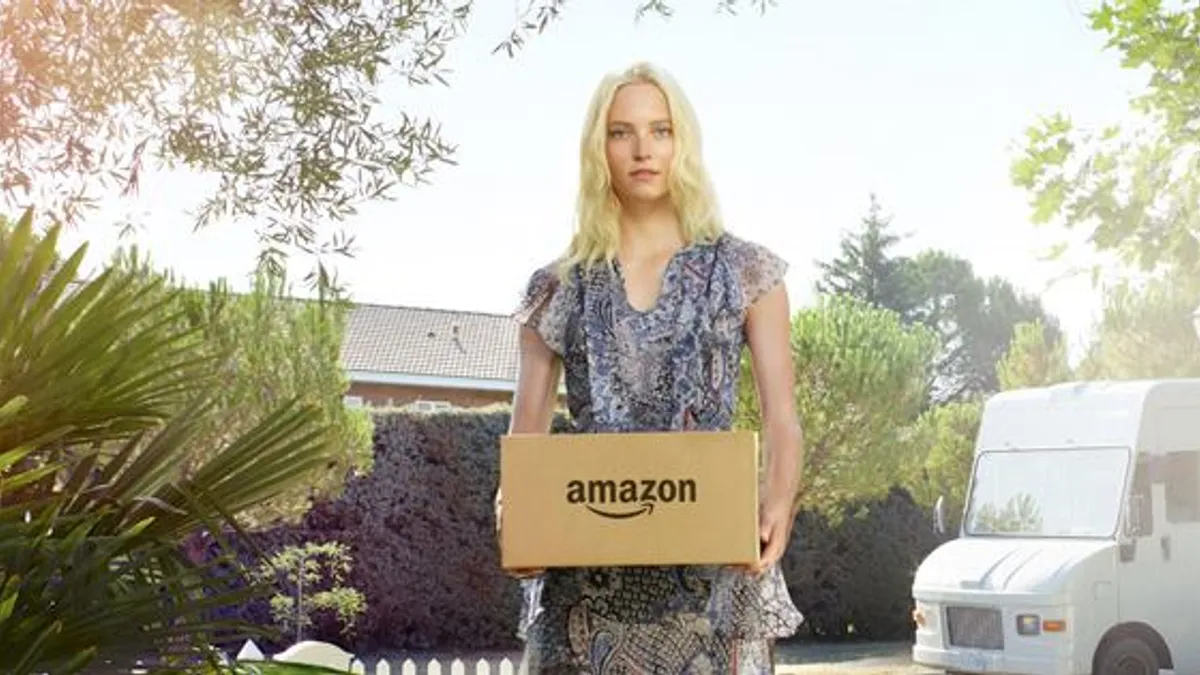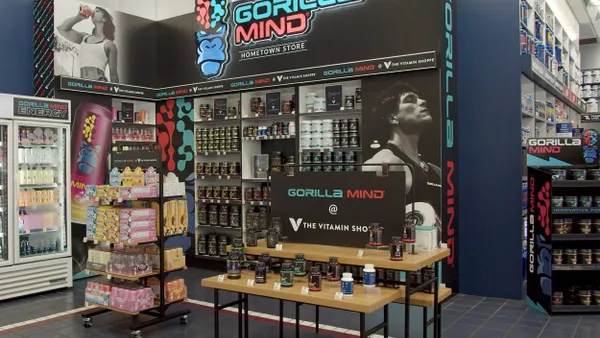By and large, Amazon is making the biggest moves with mass market apparel brands. As the largest online seller of apparel, its $16.3 billion apparel sales in 2015 exceeded those of the next five competitors — Macy’s, Nordstrom, Gap, Kohl’s and Victoria’s Secret parent L Brands — combined, according to an Internet Retailer report.
Consumers purchased more than one million pairs of shoes on Amazon Prime Day in July, and when factoring in Amazon’s seven-brand private-label rollout earlier this year, it’s no wonder Cowen & Co. analysts expect the e-commerce company will dethrone Macy’s as the largest U.S. clothing retailer in 2017.
With foot traffic at malls, department stores and specialty shops on a steady downward trajectory in recent years, apparel brands have had to look for new ways to drum up growth. Clothing brands including Gap and Lands' End have taken the plunge with Amazon in hopes of expanding their customer bases. Their focus is to be where the consumer is, and that’s on Amazon.
“The universe of products that falls into the commoditized world is huge," Sucharita Mulpuru, ShopTalk chief retail strategist and former retail analyst at Forrester Research, told Retail Dive. "With these types of products and the biggest selection of them anywhere, Amazon can easily become the biggest apparel seller in the world.”
Yet many high-end luxury labels have resisted partnering with the e-commerce giant, fearing that tradeoffs like discounting and counterfeiting are too great, and instead have looked for ways to bolster their own channels.
Hesitation from luxury
Amazon may have been stealthy with its private-label apparel rollout, but the company made no secret about its high-fashion ambitions with the bevy of well-dressed beauties bringing fashion-packed Amazon boxes to doorsteps in its splashy “Delivering Fashion” ad campaign earlier this year.
Despite its eagerness to muscle in on a slice of the more than $1 trillion global luxury pie, Amazon may be in for a steely reception from high-end labels. Moet Hennessy Louis Vuitton CFO Jean-Jacques Guiony told investors in no uncertain terms on its third-quarter earnings call that it has no plans to sell on Amazon.
“We believe that the existing business of Amazon doesn’t fit our luxury, full stop, but also doesn’t fit with our brands,” Guiony said. “If they change the business model, I don’t know, but with the existing business model, there is no way we can do business with them for the time being.”
Counterfeiting may be one reason why luxury brands are hesitant to list products on Amazon’s platform: LVMH already earmarks around $16 million annually to deal with global counterfeiters. Like fellow e-commerce marketplaces Alibaba and eBay, Amazon has had more than its fair share of fakes popping up on the platform. “Birkenstock took product off Amazon for exactly that reason. Apple had the same issue, too,” Mulpuru said.
Birkenstock not only stopped dealing with Amazon directly but also won’t authorize third-party sellers to do business on the marketplace, either. Amazon's reputation in some respects has grown to mirror an online flea market; CNBC recently described it as a “chaotic, somewhat lawless, bazaar with unlimited inventory” — which isn't exactly the ideal place to sell expensive, aspirational attire.
Another reason some apparel brands are reluctant to partner with Amazon is the entrenched fear of the pricing bait-and-switch seen with other major channels like department stores. Typically, they’d slash the brand’s product prices and then turn around and ask the brand to pay for the cost of running the promotion that the department store implemented in the first place. “They weren’t the greatest full-price selling partner,” Matt McClintock, Barclays senior retail analyst, told Retail Dive. “People are very worried that Amazon will be a similar setup.”
However, apparel brands and retailers should consider just how easy Amazon makes purchasing anything, just about anywhere. “There’s probably a new evolution with impulse purchases that’s coming that Amazon is tapping into with Echo,” McClintock noted of the voice-controlled hands-free device. In the not too distant future, technology is evolving such that the consumer may see someone on TV wearing a cool T-shirt, order it through Echo, and have the product arrive two days later. Brands already selling through Amazon will be poised to capitalize on these in-the-moment unplanned purchases.
Preserving scarcity — a strategy on which so many luxury brands are built — is yet another reason why premium fashion brands are saying no to Amazon, at least for the moment. “Scarcity drives value,” McClintock said. “As soon as the brand is everywhere, it becomes meaningless.”
Innovative stores stand out
While there may not be a “one size fits all” formula for every brand to follow, apparel labels will need to be thoughtful in determining not only how Amazon fits into their multichannel strategy but also how to leverage the power of omnichannel retailing to buttress their brands.
A search for “Nike” on Amazon, for example, will yield an array of hats, shoes, clothing, accessories and more, but what’s missing are the “marquee” products such as the hotly anticipated LeBron 14 basketball sneaker, according to McClintock, who covers Nike stock for Barclays. “Nike can completely control where that product gets sold and they segment the market very much,” he said. “They tend to sell their best, most innovative product with premium retailers who demonstrate the product in the most amazing light.”
That “amazing light” is a big part of what contributed to the initial success of brands like Abercrombie & Fitch, for example, McClintock notes. Take the logoed T-shirts out of the exciting, nightclub-esque environment packed with shirtless lifeguards and cute girls, and suddenly, the product itself doesn’t seem quite so compelling.
Given everything competing for their attention, consumers today need a good reason to visit a physical store, and Nike just gave them one. The athletic apparel and footwear retailer invested major dollars in its high-tech SoHo flagship, which opened on Nov. 18, to entice shoppers to make the trip. On the fifth floor, shoppers can try out new shoes on a basketball court and get critiques of their moves (or lack thereof) from Division 1 players. There’s a soccer turf, too, where Nike gives shoppers a running start before committing to the purchase.
“This is how the physical store is evolving,” McClintock says. Omnichannel plus experiential retailing, he adds, is what builds strong, successful brands.
“Amazon has yet to create a virtual environment that is as impressive as what you get in the physical world. Until they do — which will probably happen with virtual reality in 10 years — the physical world is always going to be necessary to sell higher-end product,” McClintock said.
Products unfamiliar to the consumer will continue to have a place in the physical store environment when the look, fit and fabric are new and novel, McClintock said, adding, “Then you kind of have to see it in the physical world before you start getting used to buying it in a virtual world.”
Is selling through Amazon inevitable?
In a nutshell: no. It may feel at times that all roads lead to Amazon but for some apparel brands, the real danger is overdiversification.
Jordache lost its once-premium appeal once it became too widely available. The denim brand’s meteoric rise from scrappy high-end jeanswear label to a lifestyle behemoth came crashing down as a result of its $300 million in licensing agreements to produce everything from luggage and socks to, at a particularly low point, designer diapers.
Jordache may be a cautionary tale for some apparel brands enticed by what Amazon offers. “It's easy for the customer to have a one-stop shop, but elite brands are very conscious of what is adjacent to them," Mulpuru said of selling on the e-commerce marketplace. "And over time, shoppers don't revere these widely available brands anymore.”
Any talk about selling on Amazon as a “must” is reminiscent of past rumblings about Wal-Mart being the quintessential retail partner, Paula Rosenblum, RSR managing partner, wrote in an email to Retail Dive. “Somehow we all have a hard time grasping the notion that no markets are infinite,” she said. “I know Amazon would like us to believe that it will always have the best prices and the most items. They can get stuck on the same sword they’ve attached everyone else too….which is that they may not.”
For many mid-market apparel labels — brands found in mid- to low-tier department stores, whose popularity has faded — Amazon just may be the next, or final, step on their journey.
"Some struggling mid-tier brands will have their swan songs on Amazon. In fact, I expect it will be part of the product lifecycle for some brands to eventually sell on Amazon," Mulpuru said. “But fashion is constantly evolving and new brands will rise, and most of those new brands will find distribution, at least initially, outside Amazon."











